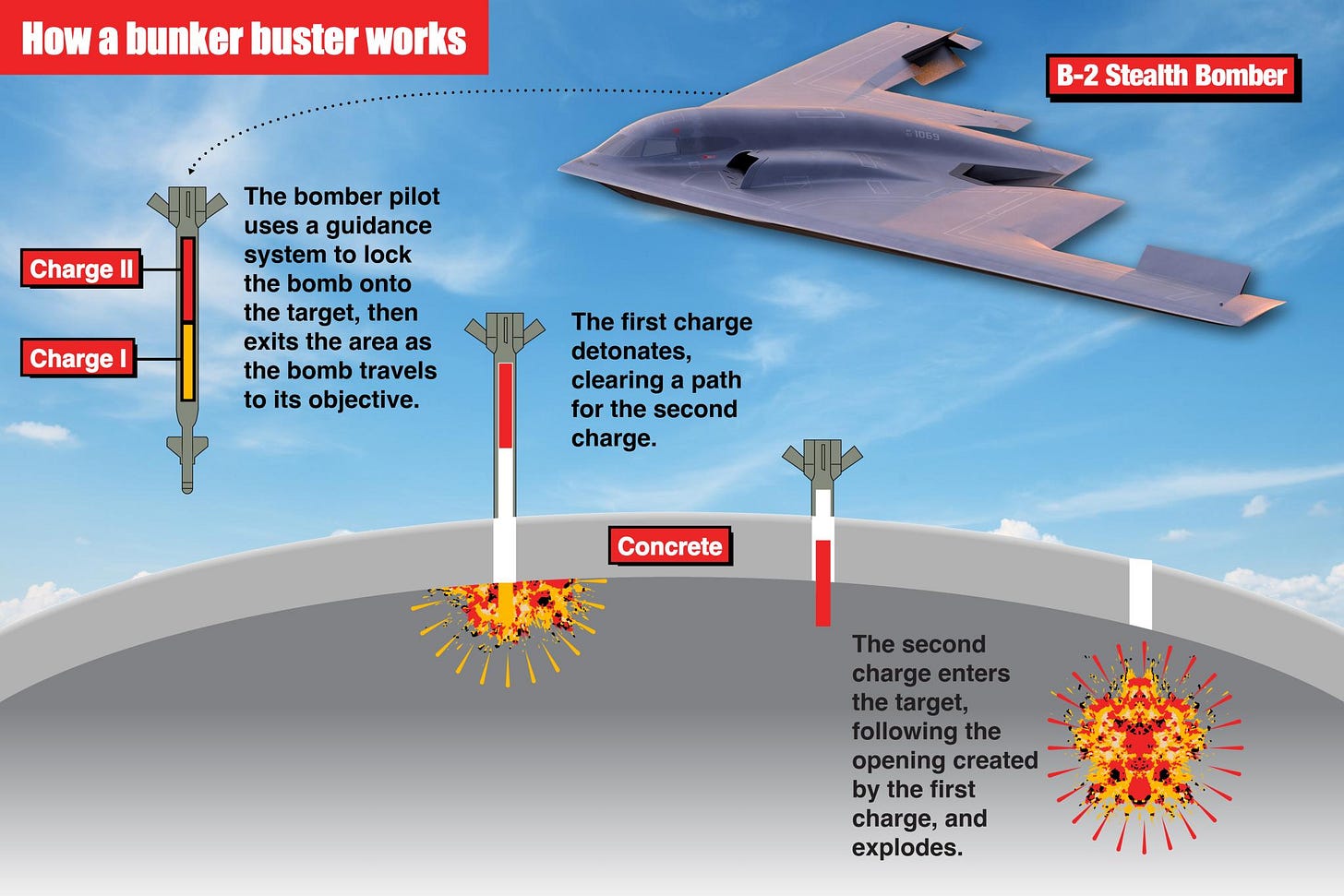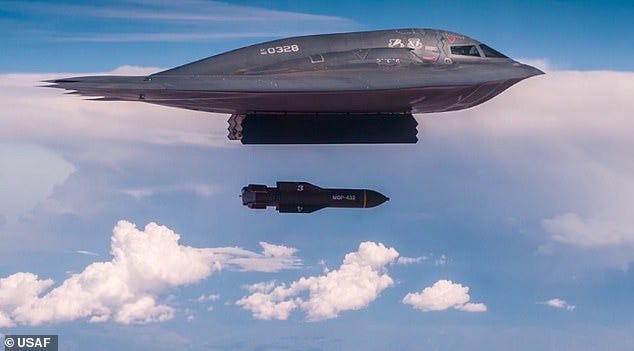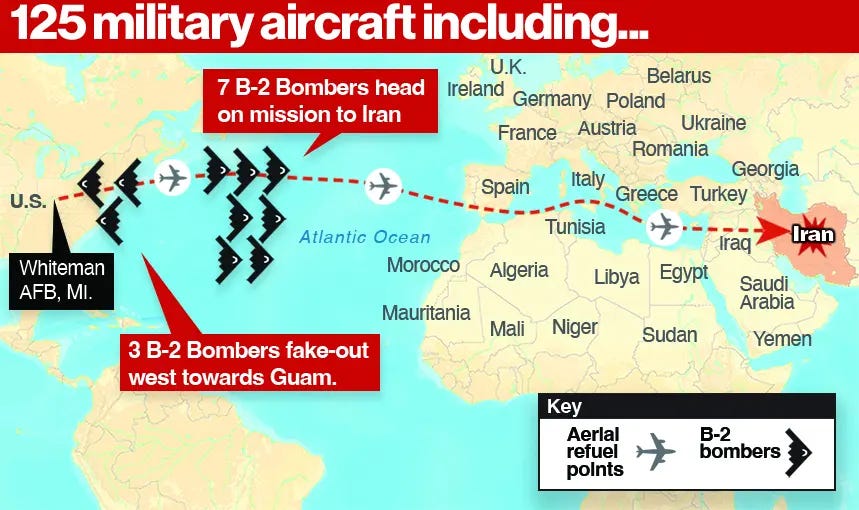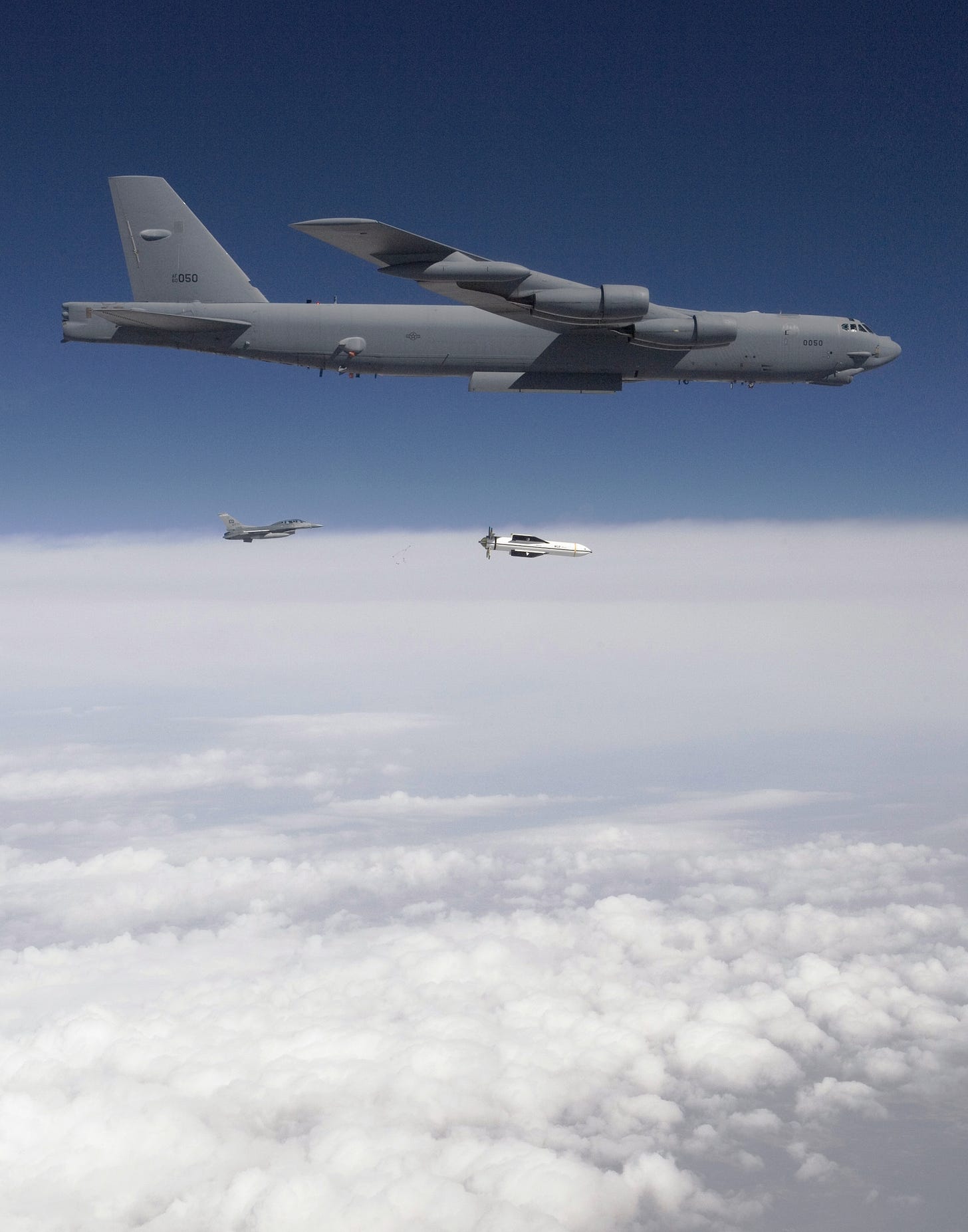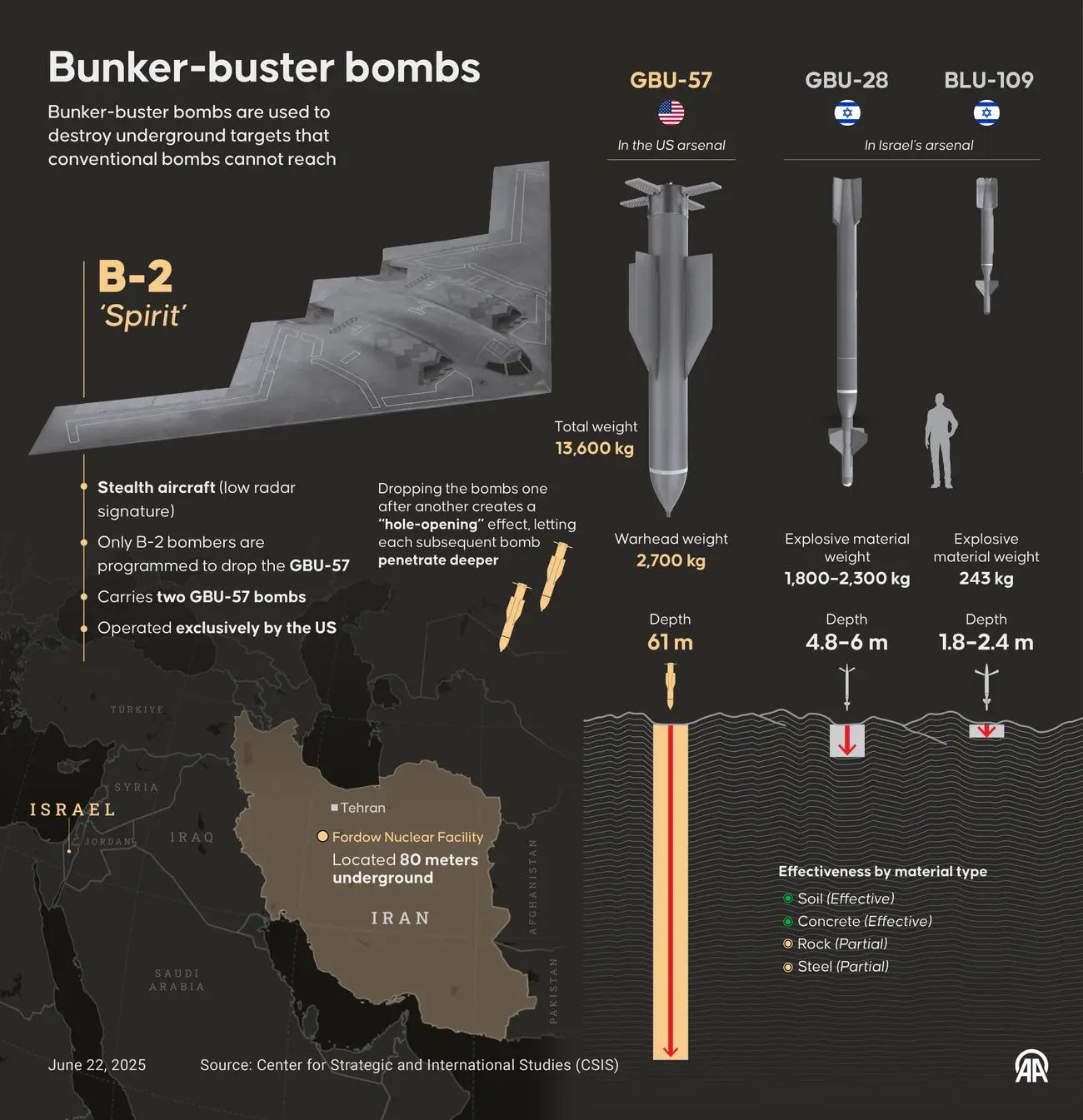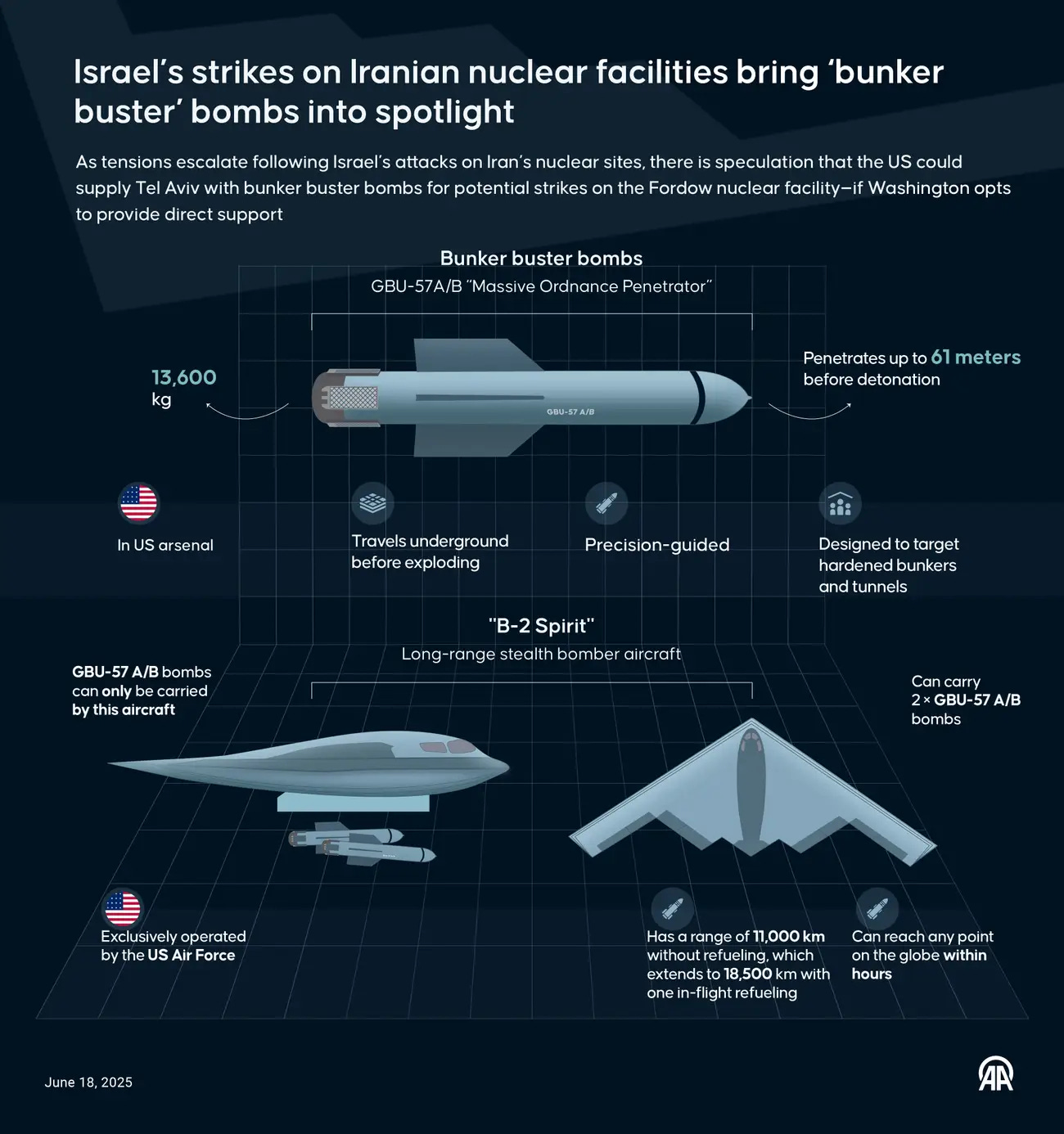How 14 bombs changed history: The largest non-nuclear weapon in the U.S. arsenal was just used in the largest stealth bomber strike in history.
Operation Midnight Hammer
The Engineer's Perspective is a reader-supported publication. Sign and up and subscribe to see more in-depth Aerospace/Aeronautical Analysis!
The GBU-57 Massive Ordnance Penetrator (MOP) redefines what’s possible in precision-guided munitions, engineered to destroy the world’s most hardened underground targets. Its combat debut during Operation Midnight Hammer in June 2025—where B-2 Spirit bombers struck Iran’s deeply buried nuclear sites—showcased unprecedented systems integration and operational precision.
The demonstrated performance of the GBU-57 MOP during Operation Midnight Hammer highlights the role of systems engineering in delivering strategic effects against hardened, asymmetric threats. By integrating and balancing the challenges of extreme kinetic penetration, precision guidance, and stealth platform integration, the MOP enables the achievement of high-priority mission objectives with minimized collateral impact. This operation exemplifies how the disciplined application of systems engineering can resolve complex operational challenges and advance the state of the art in strategic strike capabilities.
Historical Development:
The development of the GBU-57 Massive Ordnance Penetrator (MOP) traces its origins to the evolving challenge of neutralizing deeply buried and fortified military targets—specifically, underground facilities associated with weapons of mass destruction (WMD) programs. The limitations of existing conventional munitions became apparent in the late 1990s and early 2000s, as adversaries increasingly constructed critical infrastructure beneath substantial layers of reinforced concrete and earth.
The initial response was the BLU-109 and BLU-113 series “bunker buster” bombs, which saw use in conflicts such as the Gulf War and Operation Iraqi Freedom. However, intelligence assessments in the early 2000s indicated that adversary tunneling and fortification techniques were rapidly outpacing the penetrative capabilities of these weapons.
Recognizing this gap, the U.S. Air Force initiated the MOP program in 2004, tasking Boeing with the design and development of a next-generation penetrator. Early milestones included the successful fabrication of a 30,000-pound steel-cased munition and the integration of advanced GPS-aided inertial navigation systems. By 2007, the first prototypes underwent sled and live-drop tests at Eglin Air Force Base, demonstrating the structural integrity and kinetic energy required to breach over 60 meters of reinforced earth or concrete.
A major innovation came with the development of specialized fuzing mechanisms, enabling the MOP to detonate only after reaching voids or critical infrastructure deep underground. This capability was refined through iterative testing and simulation, culminating in the weapon’s initial operational capability declaration in 2011.
Throughout the 2010s, the MOP underwent further enhancements, including improvements to its guidance system for greater accuracy and the introduction of stronger steel alloys to increase penetration depth. The B-2 Spirit stealth bomber was selected as the exclusive launch platform, given its ability to deliver the MOP deep into contested airspace.
The most significant milestone in the MOP’s history occurred during Operation Midnight Hammer in June 2025, when it was employed in combat for the first time against Iran’s most fortified nuclear sites. This operation validated decades of research, development, and systems integration, firmly establishing the MOP as the world’s premier conventional weapon for defeating hardened, deeply buried targets.
Operation Midnight Hammer: The GBU-57 MOP’s Historic Combat Debut
On June 21–22, 2025, the United States launched Operation Midnight Hammer, a meticulously coordinated air campaign targeting Iran’s most secure nuclear facilities: Fordow, Natanz, and Isfahan. This operation marked the first combat use of the GBU-57 Massive Ordnance Penetrator (MOP).
Mission Planning and Preparation
Operation Midnight Hammer was the result of months of high-level planning, intelligence fusion, and logistical coordination across multiple commands. The U.S. Air Force prepositioned approximately 30 aerial refueling tankers at bases in Europe, the Middle East, and the Atlantic to guarantee the B-2s could reach their targets and return without detection. The mission’s complexity required strict operational security; only a small group of senior planners had full knowledge of the strike details.
Deception was a key element: while the main strike force of seven B-2 Spirit bombers prepared for their transatlantic journey, a second group of B-2s flew westward as decoys, drawing attention away from the true axis of advance. All communications were minimized, and the strike package maintained radio silence for much of the mission. In the days prior, U.S. and allied intelligence, surveillance, and reconnaissance (ISR) assets conducted persistent monitoring of Iranian air defenses and nuclear sites, ensuring up-to-date targeting data.
Execution and Strike Details
The B-2s departed Whiteman Air Force Base, Missouri, shortly after midnight on June 21, embarking on a non-stop, 36-hour round-trip mission. The aircraft refueled multiple times over the Atlantic and Mediterranean, seamlessly integrating with a support package of over 125 aircraft, including F-35s and F-22s for air defense suppression, RC-135s and RQ-4s for ISR, E-3 Sentry AWACS for battle management, and dozens of KC-46 tankers.
As the strike force approached Iranian airspace, U.S. Navy submarines and surface vessels in the Arabian Sea and Persian Gulf launched a coordinated barrage of Tomahawk cruise missiles. These missiles struck Iranian air defense radars, communications nodes, and surface infrastructure at Isfahan, further degrading Iran’s ability to respond. Electronic warfare aircraft jammed Iranian radar and communications, while F-35s executed suppression of enemy air defenses (SEAD) missions to neutralize any remaining threats.
At approximately 2:10 a.m. local time, the B-2s released a total of 14 GBU-57 MOPs in a carefully sequenced 25-minute window. Each MOP was guided by a GPS-aided inertial navigation system and equipped with a void-sensing fuze, allowing it to penetrate up to 200 feet of reinforced concrete and earth before detonating. The strikes focused on the most critical underground sections of the Fordow and Natanz nuclear facilities, targeting uranium enrichment halls and command centers. The B-2’s radar and targeting systems enabled real-time adjustments, ensuring sub-five-meter accuracy and maximizing the destructive effect of each MOP.
Minutes after the MOPs struck, a second wave of Tomahawk missiles hit Isfahan, targeting both surface and subsurface infrastructure to ensure the complete neutralization of Iran’s nuclear capabilities.
Strategic and Technological Significance
Operation Midnight Hammer showcased the U.S. military’s ability to execute a complex, multi-domain global strike with unprecedented precision and stealth. The GBU-57 MOP’s performance validated its status as the world’s most advanced conventional penetrator, capable of destroying targets previously thought invulnerable. The operation highlighted the effectiveness of systems integration—from aerial refueling and electronic warfare to real-time ISR and precision targeting—setting a new standard for future counter-proliferation and strategic strike missions.
Beyond its immediate military success, the mission sent a powerful signal to adversaries and allies alike: the United States retains the capability and resolve to neutralize WMD threats, even those protected by the most advanced defenses and deepest fortifications. The lessons learned from Operation Midnight Hammer will inform future doctrine, technology development, and global strike planning for years to come.
Implications
The operational use of the GBU-57 Massive Ordnance Penetrator (MOP) during Operation Midnight Hammer carries significant implications across strategic, military, and geopolitical domains.
Strategic and Military Implications
Enhanced Capability Against Hardened Targets:
The MOP’s demonstrated ability to penetrate and destroy deeply buried, fortified nuclear facilities—such as Iran’s Fordow and Natanz sites—reshapes the calculus for counter-proliferation operations. It provides the U.S. military with a reliable conventional option to neutralize underground WMD infrastructure that was previously considered nearly impervious to air strikes.Force Multiplication via Systems Integration:
The successful integration of the MOP with the B-2 Spirit stealth bomber, supported by a complex joint force of over 125 aircraft including electronic warfare and aerial refueling assets, highlights the importance of multi-domain operational synergy. This sets a new benchmark for precision strike missions in contested environments, emphasizing stealth, long-range reach, and precision-guided munitions working in concert.Operational Deterrence and Escalation Control:
By achieving strategic effects without resorting to nuclear weapons or large-scale ground operations, the MOP enables calibrated military responses that can degrade adversary capabilities while limiting escalation. This capability may deter adversaries from pursuing deeply buried WMD programs, knowing that physical protection alone no longer guarantees immunity.Limitations and Stockpile Considerations:
Despite its success, the MOP’s size and delivery constraints—limited to the B-2 platform and a relatively small stockpile—highlight challenges in scalability and sustained operations. This underscores the need for continued development of complementary penetrator technologies and platform integration to maintain operational flexibility.
Specifications
The GBU-57 Massive Ordnance Penetrator (MOP) is a precision-guided, air-delivered munition developed to address the challenge of hardened and deeply buried targets (HDBTs). Its design leverages advanced materials, guidance systems, and fuzing technology to achieve high levels of penetration and target effect.
Technical Specifications
Total Weight: 30,000 lb (13,608 kg)
Length: 20.5 ft (6.2 m)
Diameter: 31.5 in (0.8 m)
Warhead: 5,342 lb (2,423 kg) PBXN-114 high explosive
Casing Material: High-strength Eglin steel alloy, optimized for impact resistance and penetration
Guidance System: GPS-aided Inertial Navigation System (INS) with aerodynamic grid fins for mid-course correction
Accuracy: Circular Error Probable (CEP) of less than 5 meters
Penetration Capability:
Up to 200 ft (61 m) of 5,000 psi reinforced concrete
Up to 130 ft (40 m) of moderately hard rock
Fuzing: Programmable void-sensing fuze, enabling delayed detonation upon reaching target voids or specific structural features
Delivery Platform: Compatible exclusively with the B-2 Spirit stealth bomber (up to two MOPs per aircraft); integration with the B-21 Raider is planned
Features and Operational Considerations
Kinetic Penetration: The MOP is released from high altitude (typically up to 50,000 ft), achieving significant kinetic energy at impact to facilitate deep penetration prior to detonation.
Precision Guidance: The GPS/INS system, supplemented by aerodynamic control surfaces, enables accurate delivery to target coordinates, even in environments subject to electronic countermeasures.
Warhead Optimization: The explosive fill is formulated for maximum effectiveness in confined underground spaces, enhancing overpressure and structural damage.
Fuzing Flexibility: The advanced fuze can be programmed for various detonation scenarios, including delayed or void-sensing modes, to accommodate different target sets.
Stealth Integration: The weapon is designed for internal carriage by stealth platforms, allowing for delivery in contested airspace with reduced risk of detection.
Distinguishing Characteristics
Penetration Depth: The MOP’s penetration capability exceeds that of previous-generation conventional munitions, addressing a critical operational requirement for engaging HDBTs.
Non-Nuclear Option: The system provides a conventional alternative for strategic target sets that previously required nuclear or multiple sequential strikes.
Operational Validation: The MOP was employed operationally during Operation Midnight Hammer (2025), where it was used to target and degrade fortified underground facilities.
The GBU-57 MOP capabilities are currently unmatched with regard to conventional strike capability against hardened underground targets with regard to its integration of mass, material science, and guidance technology in a single munition system.
Concept of Operations: GBU-57 Massive Ordnance Penetrator (MOP)
This concept of operations (CONOPS) outlines the operational framework, objectives, and procedures for the deployment and employment of the GBU-57 MOP in strategic strike missions. to defeat hardened and deeply buried targets (HDBTs) such as underground military facilities, WMD storage sites, and command bunkers. This CONOPS is high-level and not exhaustive, with the intent of providing a high overview of how the MOP can be used.
Stakeholders
U.S. Air Force Global Strike Command
Air Combat Command
Mission planners and targeting analysts
B-2 Spirit (and future B-21 Raider) aircrews
Intelligence, surveillance, and reconnaissance (ISR) teams
Department of Defense leadership
Allied defense partners (as applicable)
Purpose
The primary purpose of the GBU-57 MOP is to provide a credible, non-nuclear option for neutralizing deeply buried and fortified targets that are inaccessible to standard munitions. It is intended to support strategic deterrence, counter-proliferation, and high-value target elimination missions.
Operational Overview
Pre-Mission Planning:
Target Identification: Intelligence teams use multi-source ISR to identify and characterize HDBTs, including depth, construction materials, and potential collateral effects.
Mission Planning: Aircrews and planners develop detailed flight plans, integrate refueling and support assets, and select optimal ingress/egress routes to minimize detection.
Weapon Preparation: MOPs are loaded onto B-2 aircraft in secure facilities. Guidance and fuzing parameters are programmed based on target specifics.
Mission Execution:
Launch and Transit: B-2 bombers depart from secure bases, often requiring multiple aerial refuelings to reach distant targets while maintaining stealth.
Penetration of Defended Airspace: B-2s utilize low-observable technology, electronic warfare support, and coordinated SEAD (Suppression of Enemy Air Defenses) to penetrate contested airspace.
Weapon Release: At the designated release point and altitude (typically up to 50,000 ft), the MOP is deployed. The GPS/INS guidance system directs the bomb to the precise aimpoint.
Terminal Phase: The MOP achieves supersonic terminal velocity, using kinetic energy and advanced fuzing to penetrate deep underground before detonation at the optimal location.
Post-Strike Operations:
Battle Damage Assessment: ISR assets (satellites, drones, reconnaissance aircraft) assess strike effectiveness and provide feedback for future operations.
Debrief and Analysis: Aircrews and planners review mission data to refine tactics, techniques, and procedures (TTPs) for subsequent missions.
Key Capabilities
Deep Penetration: Able to defeat targets buried under up to 200 feet of reinforced concrete or rock.
Precision Guidance: GPS/INS and grid-fin stabilization ensure sub-5 meter CEP accuracy.
Programmable Fuzing: Void-sensing and delayed detonation options maximize effectiveness against complex underground structures.
Stealth Integration: Designed for internal carriage by B-2 and (future) B-21 bombers, enabling delivery in contested environments.
Non-Nuclear Strategic Option: Provides a conventional means to neutralize HDBTs, supporting deterrence and escalation control.
The GBU-57 MOP is a significant asset for strategic strike operations requiring the defeat of hardened underground targets. Its deployment is characterized by rigorous pre-mission planning, integration with stealth bomber platforms, and precise, high-impact delivery. The MOP enhances the U.S. military’s ability to hold adversary HDBTs at risk, providing decision-makers with a flexible and credible non-nuclear option for some of the most challenging operational scenarios.
Systems Engineering: GBU-57 Massive Ordnance Penetrator (MOP)
This systems engineering overview captures the MOP’s integration of penetration physics, guidance resilience, and platform synergy—a model for next-generation strategic munitions facing evolving underground threats.
System Objectives
Primary Functions:
Neutralize hardened, deeply buried targets (HDBTs) such as underground WMD facilities or command bunkers.
Deliver precision kinetic penetration followed by optimized explosive effects within confined subterranean spaces.
Key Operational Capabilities:
Deep penetration (200+ ft in reinforced concrete).
Sub-5m CEP accuracy under GPS-denied conditions.
Stealth-platform compatibility (B-2/B-21).
Void-sensing fuzing for dynamic target adaptation.
Mission Requirements:
Operate in contested airspace with minimal detection risk.
Survive high-G impacts (>100g) during penetration.
Minimize collateral damage through precision effects.
Performance Goals:
ParameterTargetPenetration Depth≥200 ft (5k psi concrete)Accuracy (CEP)≤5mReliability≥95% mission successAircraft Payload2x MOPs per B-2 sortie
Operating Conditions
Notional Environmental Parameters:
Temperature: -65°F to 160°F (storage/operation).
Altitude: Release at ≤50,000 ft; impact at Mach 1.2+.
Vibration: 15g during carriage; 100g+ at impact.
Notional Operational Constraints:
Exclusive to B-2/B-21 platforms (no external carriage).
Requires pre-strike geological intelligence for fuzing optimization.
Limited to 14 MOPs per mission (current stockpile).
Notional Infrastructure Requirements:
Secure storage for high-explosive warheads.
B-2-specific loading/unloading equipment.
GPS M-Code compatibility for jamming-resistant guidance.
Notional Maintenance Conditions:
24-month shelf life for explosive components.
500-hour recalibration cycle for guidance modules.
Non-destructive testing (NDT) for casing integrity post-impact.
Expected Opposition/Challenges
Potential Threats:
Adversary tunneling beyond 200ft depth.
Multi-layered composite barriers (steel-concrete-sand).
GPS jamming/spoofing in contested environments.
Counter-stealth radar advancements.
Countermeasures/Advantages:
Penetration: Tungsten-carbide nose tips for enhanced hardness.
Guidance: INS fallback mode with terrain-referenced navigation.
Stealth: Low-observable carriage reduces detection risk.
Tactical: Coordinated SEAD/DEAD support for ingress.
Design Considerations
PrincipleImplementation ExampleModularitySwappable guidance/fuze packagesScalabilityB-21 Raider integration roadmapInteroperabilityJ-series data link for in-flight retargetingCost-EffectivenessReuse of JDAM tailkit components
Verification and Validation
The below Verification and Validation procedures are merely notional, and are provided to give an idea of what is needed for a system to enter initial operation capability (IOC) and production.
Notional Testing Procedures:
Sled Tests: 300+ runs at Holloman AFB impact facility.
Live Fire: 12 full-scale drops against simulated HDBTs.
EMI Testing: Operation in GPS-jammed environments.
Notional Simulation Requirements:
Finite element analysis (FEA) for penetration dynamics.
Monte Carlo simulations for accuracy under jamming.
6-DOF modeling for terminal trajectory validation.
Notional Acceptance Criteria:
90% success rate in ≥3 consecutive penetration tests.
<1% dud rate across 50 live-fire trials.
Certification Needs:
MIL-STD-1901A (munitions safety).
JP 3-60 (joint targeting compliance).
B-2/B-21 airworthiness certification.
Systems Engineering Requirements: GBU-57 Massive Ordnance Penetrator (MOP)
Based on the aforementioned systems engineering constraints the following are notional, high-level systems engineering requirements for the GBU-57 Massive Ordnance Penetrator (MOP). From these requirements one then derives specific requirements that are then met via verification and validation:
Functional Requirements
The system shall neutralize hardened and deeply buried targets (HDBTs) through precision-guided kinetic penetration and explosive effects.
The system shall operate in both peacetime and wartime operational modes, including training, storage, transport, and live deployment.
The system shall achieve a penetration depth between "X" (Threshold) and "X" (Objective) in reinforced concrete.
The system shall provide interoperability with designated stealth bomber platforms and mission planning systems.
Physical Requirements
The system shall conform to size and weight constraints for internal carriage by the B-2 and B-21 platforms.
The system shall utilize high-strength steel alloys or equivalent materials to withstand high-impact forces.
The system shall maintain structural integrity under impact loads up to "X" g.
The system shall operate without external power during carriage and use onboard power for guidance and fuzing subsystems.
Environmental Requirements
The system shall operate within a temperature range of "X" to "X".
The system shall tolerate humidity levels between "X"% and "X"% during storage and operation.
The system shall be capable of release and operation at altitudes between "X" (Threshold) and "X" (Objective).
The system shall meet electromagnetic compatibility standards for operation in contested electronic environments.
Maintenance Requirements
The system shall require scheduled maintenance intervals not to exceed "X" months.
The system shall be maintainable using standard Air Force tools and ground support equipment.
The system shall require a skill level of "X" or higher for maintenance tasks.
The system shall have a defined spare parts logistics plan to ensure operational availability.
Interface Requirements
The system shall provide a human-machine interface for programming guidance and fuzing parameters.
The system shall interface with aircraft avionics and weapon release systems.
The system shall support secure data exchange protocols for mission planning and post-strike assessment.
The system shall be compatible with external ISR and targeting systems for real-time updates.
Safety and Reliability Requirements
The system shall comply with applicable military munitions safety standards.
The system shall achieve a reliability metric of no less than "X" mean time between failures (MTBF).
The system shall incorporate redundancy in critical guidance and fuzing subsystems.
The system shall include mitigations for identified failure modes, including dud and premature detonation risks.
Design Considerations
The system shall be modular to allow for future upgrades in guidance, fuzing, or warhead technology.
The system shall be scalable for integration with future platforms and mission profiles.
The system shall maintain interoperability with existing U.S. Air Force logistics and support systems.
The system shall be designed for cost-effectiveness in both production and lifecycle operation.
Verification and Validation
The system shall undergo qualification testing, including sled tests, live drops, and environmental stress testing.
The system shall be validated through simulation of penetration, guidance accuracy, and detonation performance.
The system shall meet acceptance criteria defined in the system specification document.
The system shall achieve certification in accordance with Department of Defense and Air Force standards.
Calculations
An example calculation that can be performed of the system can include kinetic energy at impact:
Kinetic Energy at Impact
To estimate the kinetic energy delivered upon impact, which is a primary factor in the MOP’s penetration capability.
In order to perform this calculation, we will have to make an assumption about the speed of the projectile at impact, which in this case can be at Mach 1.2 (~408m/s at sea level):
We already know the mass is 30,000 lbs, and we need to convert to kg:
The calculation for Kinetic energy (KE), is:
The MOP upon impact with the ground has roughly the same energy as that released by over 5,000 hand grenades exploding at once.
Geopolitical and Industry Implications
Impact on Global Non-Proliferation Regimes:
The MOP’s operational use sends a clear signal to states pursuing clandestine nuclear programs that deeply buried facilities are vulnerable to precision conventional strikes. This may influence diplomatic negotiations and non-proliferation enforcement strategies by increasing pressure on regimes to comply with international norms.Defense Industry Innovation Driver:
The successful deployment of the MOP validates decades of research in advanced materials, guidance systems, and bomb design, encouraging further investment in next-generation bunker-busting munitions. It also reinforces the strategic value of stealth platforms like the B-2 and the forthcoming B-21 Raider, driving continued modernization efforts in aerospace and weapons manufacturing sectors.Operational Lessons for Future Conflicts:
Operation Midnight Hammer provides a blueprint for executing complex, long-range precision strikes in contested airspace, combining stealth, electronic warfare, and precision munitions. These lessons will inform future doctrine, training, and acquisition programs aimed at maintaining technological and operational superiority in high-threat environments.
The GBU-57 MOP’s first combat use during Operation Midnight Hammer marks a significant advancement in strategic strike capability, with far-reaching consequences for military operations, deterrence postures, and defense technology development. It demonstrates how integrated systems engineering and multi-domain coordination can overcome the challenges posed by hardened underground targets, reshaping the landscape of modern warfare and international security.
Conclusion:
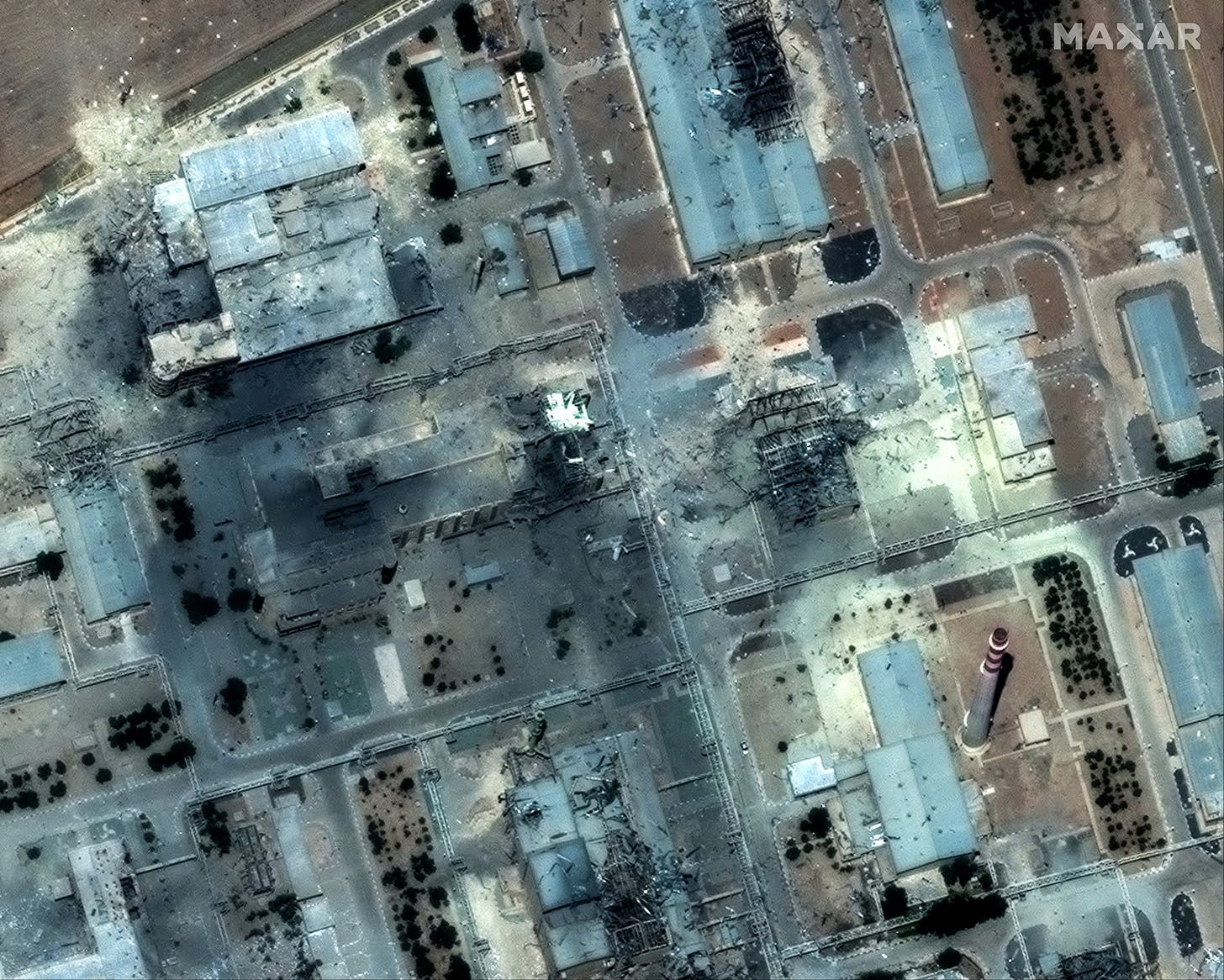
The GBU-57 Massive Ordnance Penetrator (MOP) stands as a benchmark achievement in the domain of precision-guided munitions, purpose-built to defeat hardened and deeply buried targets (HDBTs) that serve as critical nodes in weapons of mass destruction (WMD) programs. As a 30,000-pound class penetrator, the MOP synthesizes advancements in high-strength materials, structural dynamics, and guidance technology to deliver a munition with the capability to breach multi-layered reinforced concrete and substantial geological overburden—threat environments previously considered impervious to conventional air-delivered weapons.
The operational employment of the MOP during Operation Midnight Hammer (June 21–22, 2025) against Iranian nuclear infrastructure represents a significant milestone in the application of advanced systems engineering to modern warfare. This operation entailed the coordinated deployment of seven B-2 Spirit stealth bombers, each equipped with MOPs, to simultaneously engage three of Iran’s most heavily fortified nuclear sites: Fordow, Natanz, and Isfahan. Each target was characterized by extensive physical protection, including deep burial beneath mountain strata and reinforced concrete, as well as sophisticated integrated air defense systems. The mission profile demanded not only the physical destruction of these deeply buried assets but also the seamless orchestration of intelligence, surveillance, and reconnaissance (ISR), electronic warfare, aerial refueling, and precision navigation in a highly contested operational environment.
From an engineering perspective, the success of Operation Midnight Hammer was predicated on the rigorous integration of multiple critical subsystems. The MOP’s robust structural design enabled it to withstand and transmit extreme kinetic energy upon impact, while its precision guidance package—leveraging GPS-aided inertial navigation and aerodynamic control surfaces—ensured sub-five-meter circular error probable (CEP) accuracy. Furthermore, the compatibility of the MOP with the B-2 Spirit’s stealth and payload architecture was essential to mission survivability and operational reach, enabling deep penetration into defended airspace without detection or engagement.
The outcome of Operation Midnight Hammer not only validated the technical maturity and operational effectiveness of the MOP, but also provided invaluable empirical data to inform iterative design improvements. These include enhancements in penetration mechanics, guidance system resilience under GPS-denied conditions, and warhead fuzing for optimized detonation within complex underground structures. The operation serves as a compelling case study in the application of systems engineering principles to the development and employment of strategic munitions.
References:
The Weapons of Operation Midnight Hammer: MOPs, Tomahawks, and More — Air & Space Forces Magazine
Air Force Uses MOP GBU-57 to Hit Iranian Nuclear Sites in ‘Midnight Hammer’ — DefenseScoop
Inside Operation Midnight Hammer: U.S. Dropped 14 Bunker-Buster Bombs on Fordow in Historic B-2 Raid — New York Post
What Operation Midnight Hammer Means for the Future of Iran’s Nuclear Ambitions — CSIS
With GBU-57s, U.S. Finally Deploys Weapon Designed Specifically for Iran’s Hardened Nuclear Sites — Forecast International
Pentagon Briefing: U.S. Strikes on Iran Nuclear Sites — CBS News
How the U.S. Conducted Surprise Strikes on Iran — Breaking Defense
What We Know About B-2 Strikes on Iran: Operation Midnight Hammer — The War Zone
Operation Midnight Hammer: U.S. Airstrikes on Iran's Nuclear Sites — The Aviationist
The Engineer's Perspective is a reader-supported publication. To receive new posts and support my work, consider becoming a free or paid subscriber.


